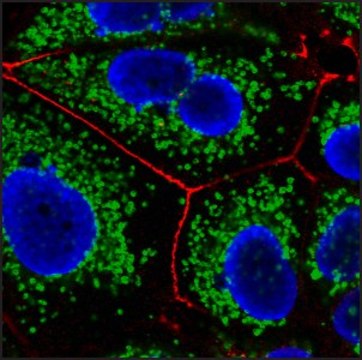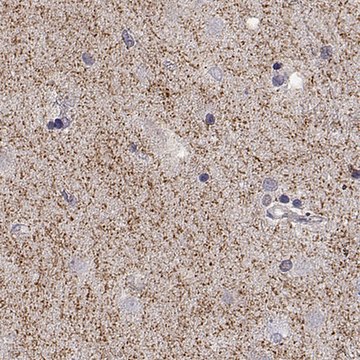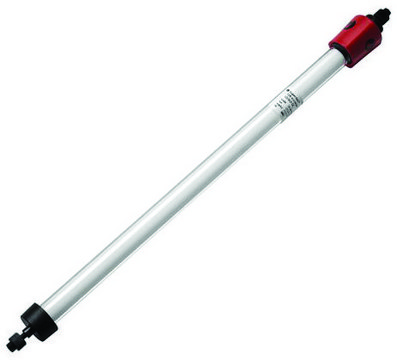MABN685
Anti-KDM4A Antibody, clone5H1
ascites fluid, clone 5H1, from mouse
Synonym(s):
Lysine-specific demethylase 4A, JmjC domain-containing histone demethylation protein 3A, Jumonji domain-containing protein 2A, KDM4A
Sign Into View Organizational & Contract Pricing
Select a Size
All Photos(3)
Select a Size
Change View
About This Item
UNSPSC Code:
12352203
eCl@ss:
32160702
NACRES:
NA.41
Recommended Products
General description
Lysine methylation of histones is associated with both transcriptionally active chromatin and with silent chromatin, depending on what residue is modified. Histone methyltransferases and demethylases ensure that histone methylations are dynamic and can vary depending on cell cycle or developmental stage. KDM4A demethylates H3K36me3, a modification enriched in the 3′ end of active genes. KDM4A is also known as Lysine-specific demethylase 4A or JmjC domain-containing histone demethylation protein 3A, or Jumonji domain-containing protein 2A, and is encoded by the human gene named KDM4A/JHDM3A/JMJD2/JMJD2A/KIAA0677. KDM4A is the histone demethylase that specifically demethylates ′Lys-9′ and ′Lys-36′ residues of histone H3, thereby playing a central role in histone gene repression, and KDM4A functions as a trimethylation-specific demethylase, converting specific trimethylated histone residues to the dimethylated forms. KDM4A does not demethylate histone H3 ′Lys-4′, H3 ′Lys-27′ nor H4 ′Lys-20′, but KDM4A does demethylate trimethylated H3 ′Lys-9′ and H3 ′Lys-36′ residues, while it has no activity on mono- and dimethylated residues. KDM4A also plays a critical role in muscle differentiation as demethylation of various targets allows influences the expression of the Myog gene family critical in muscle cell development. KDMA4A also interacts with histone deacetylases HDAC1, HDAC2, and HCAC3. It is localized in the nucleus and widely expressed. KDM4A’s own levels are mediated via ubiquitination and proteasome degradation. EMD-Millipore’s Anti-KDM4A mouse monoclonal antibody has been tested in western blot on HEK293 and KDM4A transfected HEK293 cell lysates and in paraffin embedded immunohistochemistry on human colon and larynx cancer tissues and in fluorescent immunocytochemistry on NTERA-2 cells in culture.
Immunogen
Purified recombinant fragment of human KDM4A expressed in E. Coli.
Application
Anti-KDM4A Antibody, clone5H1 is a highly specific mouse monoclonal antibody, that targets Jumonji domain-containing protein (JMJD) & has been tested in western blotting, IHC & Immunofluorescence.
Immunohistochemistry Analysis: A 1:200-1,000 dilution from a representative lot detected KDM4A in human colon cancer and larynx cancer tissues.
Immunofluorescence Analysis: A 1:200-1,000 dilution from a representative lot detected KDM4A in NTERA-2 cells.
Optimal working dilutions must be determined by end user.
Immunofluorescence Analysis: A 1:200-1,000 dilution from a representative lot detected KDM4A in NTERA-2 cells.
Optimal working dilutions must be determined by end user.
Quality
Evaluated by Western Blotting in HEK293 and KDM4A-hIgGFc transfected HEK293 cell lysates.
Western Blotting Analysis: A 1:500-2,000 dilution of this antibody detected KDM4A-hIgGFc transfected HEK293 cell lysates.
Western Blotting Analysis: A 1:500-2,000 dilution of this antibody detected KDM4A-hIgGFc transfected HEK293 cell lysates.
Target description
~72 kDa observed
Analysis Note
Control
HEK293 and KDM4A-hIgGFc transfected HEK293 cell lysates
HEK293 and KDM4A-hIgGFc transfected HEK293 cell lysates
Not finding the right product?
Try our Product Selector Tool.
Storage Class
12 - Non Combustible Liquids
wgk_germany
nwg
flash_point_f
Not applicable
flash_point_c
Not applicable
Certificates of Analysis (COA)
Search for Certificates of Analysis (COA) by entering the products Lot/Batch Number. Lot and Batch Numbers can be found on a product’s label following the words ‘Lot’ or ‘Batch’.
Already Own This Product?
Find documentation for the products that you have recently purchased in the Document Library.
Our team of scientists has experience in all areas of research including Life Science, Material Science, Chemical Synthesis, Chromatography, Analytical and many others.
Contact Technical Service








